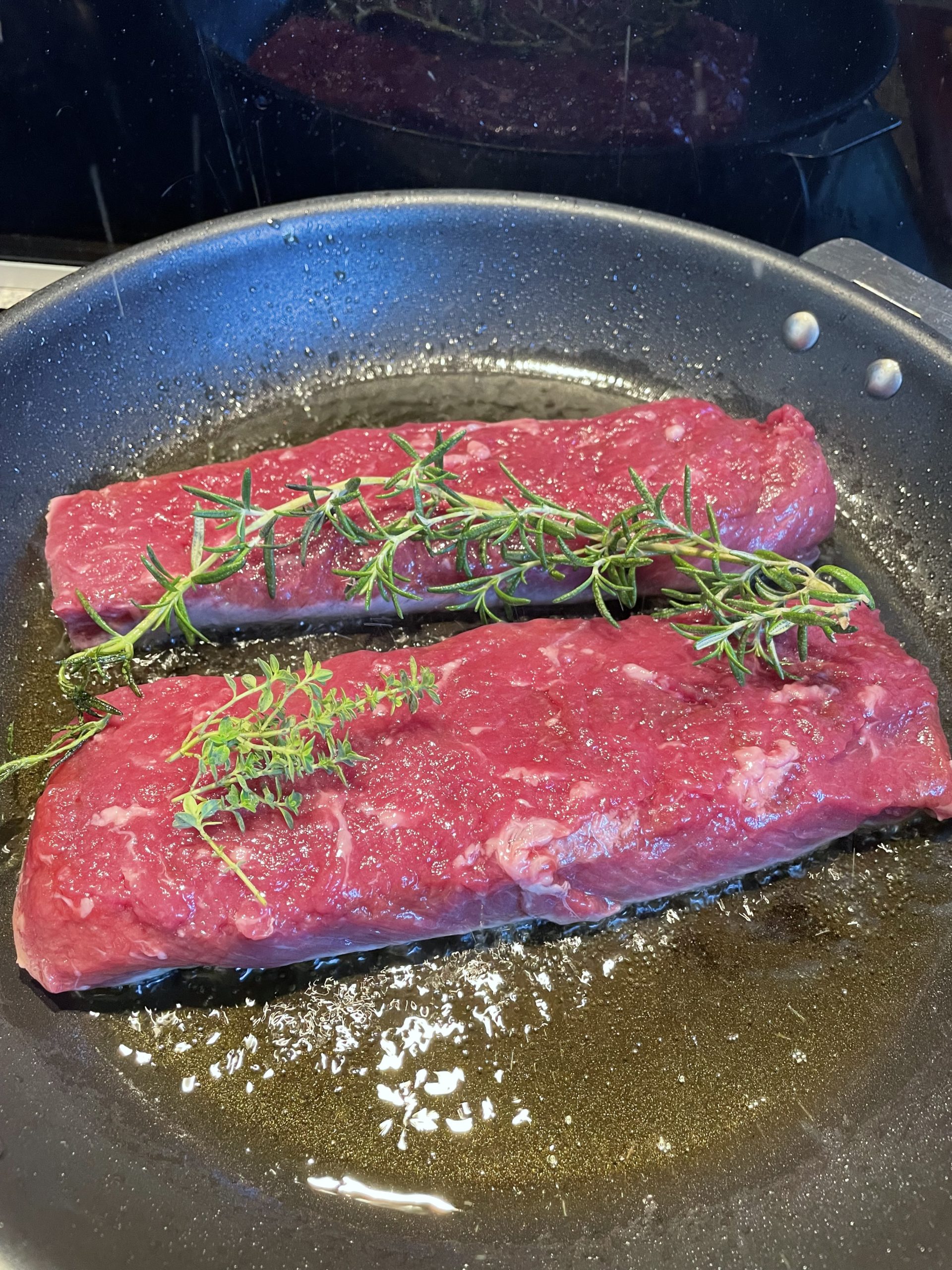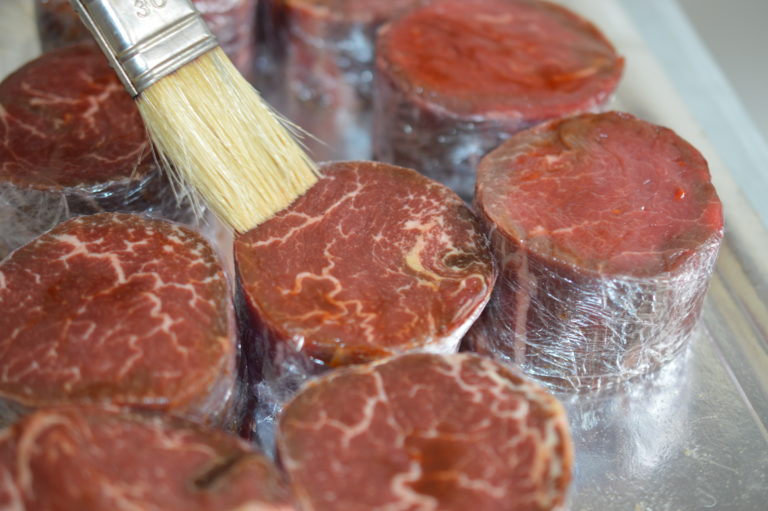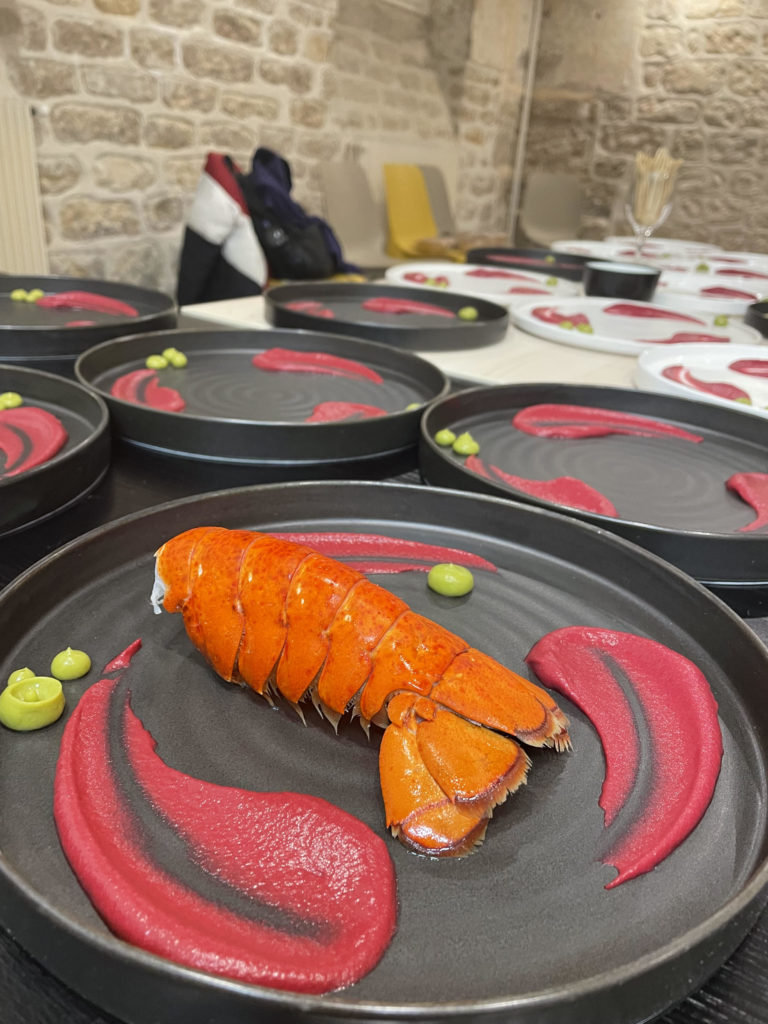Roasted Herb-Crusted Lamb Fillet
Ingredients:
- 2 lamb fillets (about 500g each)
- 2 tablespoons olive oil
- 2 cloves garlic, minced
- 2 tablespoons Dijon mustard
- 2 tablespoons honey
- 1 tablespoon fresh thyme, chopped
- 1 tablespoon fresh rosemary, chopped
- Salt and freshly ground black pepper, to taste
Instructions to Make a Perfect Lamb Fillet:
- Preheat your oven to 200°C (thermostat 6-7).
- Season the lamb fillets with salt and pepper on all sides.
- In a pan, heat the olive oil over medium-high heat. Sear the lamb fillets on both sides until they are golden brown, about 2-3 minutes per side.
- Meanwhile, in a bowl, mix the Dijon mustard, honey, minced garlic, chopped thyme, and chopped rosemary.
- Once the lamb fillets are browned, remove them from the pan and place them in an ovenproof baking dish.
- Generously brush the lamb fillets with the mustard, honey, and herb mixture, making sure to coat them evenly.
- Place the lamb fillets in the preheated oven and roast them for about 15 to 20 minutes for medium-rare, or longer if you prefer the meat more cooked. Use a meat thermometer to check the internal temperature, which should reach 60°C for medium-rare.
- Once cooked, remove the lamb fillets from the oven and let them rest for a few minutes before slicing them into thick slices.
- Serve the roasted lamb slices with a garnish of your choice, such as grilled vegetables, roasted potatoes, or a green salad.
This simple recipe highlights the delicate flavor of lamb while giving it a touch of garlic, mustard, and fresh herbs. Bon appétit!
Lamb Fillet and its Tenderness
Choosing the right meat is an important decision in cooking, as it greatly influences the taste and texture of a dish. Among the many available options, lamb fillet stands out for its elegance, exceptional tenderness, and delicate flavor. In this article, we will explore the reasons why choosing a lamb fillet is a top culinary choice.
- Unmatched Tenderness: Lamb fillet is renowned for its exceptional tenderness. Due to its position in the animal’s body, which is less used, this meat is incredibly tender, making it perfect for various culinary preparations. Whether you roast it, grill it, braise it, or cook it in a pan, lamb fillet will retain its tender texture.
- Delicate Flavor: Lamb fillet offers a soft and subtle flavor that pairs perfectly with a wide variety of aromas and spices. Its delicate flavor makes it a culinary canvas, allowing creative chefs to experiment with different marinades and seasonings to create unique and delicious dishes.
- Versatility in the Kitchen: The versatility of lamb fillet makes it an ideal choice for all types of occasions. You can serve it for a family dinner or offer it as a main dish for an elegant reception. It also pairs well with a variety of sides, from roasted vegetables to refined sauces.
- Nutritional Value: Lamb fillet is also an excellent source of high-quality proteins, iron, zinc, and B vitamins, making it a nutritious choice for those looking to maintain a balanced diet.
- Tradition and Culture: Lamb is a meat that plays an integral role in many cultures around the world. Choose lamb fillet to embrace the richness of culinary traditions from the Middle East, the Mediterranean, and other regions where lamb is an undisputed star in the kitchen.
What to Serve with Lamb?
Choosing lamb fillet for your next meal is a decision that combines tenderness, flavor, and versatility in the kitchen. Whether you are an experienced cook or just want to create a memorable meal, lamb fillet provides a delicious backdrop for expressing your culinary creativity. Feel free to explore the many recipes and cooking techniques available to discover all that lamb fillet has to offer for your gourmet palate.
When preparing a delicious lamb dish, choosing the right side dishes plays an essential role in creating a balanced and memorable culinary experience. Lamb, with its unique flavor and tenderness, pairs harmoniously with a variety of accompaniments that highlight its qualities. Here are some suggestions for choosing the perfect side dishes for your lamb dish:
- Seasonal Vegetables: Seasonal vegetables add a touch of freshness and color to your lamb dish. Opt for grilled vegetables like asparagus, green beans, carrots, or zucchini for a subtly charred flavor that complements the lamb well.
- Potatoes: Potatoes come in many forms to accompany lamb. Whether roasted, mashed with cream, gratin-style, or as new potatoes, they provide a satisfying texture that contrasts perfectly with the tenderness of lamb.
- Legumes: Legumes like chickpeas, lentils, or broad beans add a touch of plant-based protein and fiber to your meal, offering a variety of textures and flavors that pair well with lamb.
- Herbs and Spices: Fresh aromatic herbs like thyme, rosemary, mint, and coriander, as well as spices like cumin, cinnamon, or paprika, can be used to enhance the flavor of lamb and create a sensory harmony in your dish.
- Refined Sauces: A well-chosen sauce can transform a lamb dish into a gourmet feast. Classic sauces like mint sauce, red wine sauce, honey and mustard sauce, or yogurt and garlic sauce are excellent choices to accompany lamb.
- Fresh Salads: A light and fresh salad can add brightness to your lamb meal. Opt for a simple green salad with a light vinaigrette to balance the richness of the meat.
- Risotto: A creamy risotto made with broth, parmesan, and fresh herbs is a great accompaniment to lamb, adding a velvety texture and rich flavor to your meal.
- Cheese: Hard cheeses like pecorino or parmesan can add a touch of richness and umami to a lamb dish. You can grate them over the lamb just before serving or include them in a sauce or gratin.
- Fruits: Fruits like figs, apricots, or apples can be used to create sweet jams or chutneys that contrast beautifully with the savory flavor of lamb. These accompaniments bring a sweet and tangy touch to every bite.
- Bread and Flatbreads: Fresh breads, naans, pitas, or crispy baguettes are perfect for accompanying lamb, allowing you to enjoy each piece of meat with a bite of soft bread.
- Wine: Lamb also pairs well with a selection of red wines. A Bordeaux, Cabernet Sauvignon, or Syrah can complement the robust flavor of lamb, while a full-bodied dry white wine like Chardonnay can provide an interesting alternative.
- Slow Cooking: If you prefer a slower cooking approach, consider braising the lamb in a Dutch oven with vegetables, herbs, and wine to create a long-cooked, rich, and comforting dish.
- Charcuterie: Thin slices of charcuterie like Parma ham, prosciutto, or chorizo can add a touch of saltiness and complexity to your lamb dish.
Ultimately, lamb offers a blank canvas for culinary experimentation. Whether you’re preparing a simple family meal or a gourmet dinner, there are many possibilities for accompanying this exquisite meat. The key is to create a balanced culinary experience that highlights the unique flavor and tenderness of lamb while offering a variety of textures, flavors, and sensations to delight your guests. Don’t be afraid to explore and personalize your choice of accompaniment to create a memorable feast around this exceptional meat.
Eating Lamb
Eating lamb offers several benefits, both culinary and nutritional. Here are some reasons why you might choose to include lamb in your diet:
- Delicious Flavor: Lamb has a unique and delicious flavor that is enjoyed by many. Its subtle, sweet flavor makes it an ideal canvas for a variety of seasonings and culinary preparations.
- Tenderness: Lamb is one of the most tender meats available, especially lamb fillet. Its tenderness makes it a popular choice for roasted, grilled, or braised dishes.
- Variety: Lamb offers a variety of cuts, from fillet and chops to shoulder and leg, allowing you to create a wide range of dishes to suit your preferences.
- Rich in Protein: Lamb is an excellent source of high-quality protein. Protein is essential for growth, tissue repair, and overall health.
- Essential Nutrients: Lamb is also a source of important nutrients such as iron, zinc, vitamin B12, and selenium. These nutrients play a crucial role in the proper functioning of the body.
- Versatility in the Kitchen: Lamb is suitable for a wide range of culinary preparations. You can grill, roast, pan-fry, braise, or stew it, and it pairs well with a variety of sides and seasonings.
- Cultural Tradition: In many cultures around the world, lamb occupies a prominent place in traditional cuisine. It is often associated with festive dishes and symbolizes conviviality and celebration.
- Sustainability: Depending on the source of your lamb, it can be considered a more sustainable meat option compared to others, as sheep can be raised in a wider variety of environments than cattle.
- Dietary Variety: Lamb can be an alternative to other types of meat, such as beef or pork, offering variety in your diet.
However, it is important to note that lamb should be consumed in moderation, as with any meat. It is also recommended to choose sustainably raised lamb and opt for lean cuts to reduce the intake of saturated fats.
In summary, eating lamb can be a delicious and nutritious choice for diversifying your diet and enjoying the unique flavors and tenderness of this meat. When consumed in moderation and as part of a balanced diet, lamb can be part of a healthy and satisfying eating plan.







